Game Sense -
Art of Predicting
The Run of Play
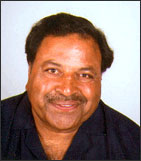
For more coaching information, visit www.coachshiv.com
| January | February | March |
|
April | May | June |
|  |
|||||
| July | August | September | October | November | December | |
![]()
INTRODUCTION
plus ça change, plus c'est la même chose - The more things change, the more they remain the same.
- Jean-Baptiste Alphonse Karr
The game of field hockey has changed, but not its basic concepts. There might be slight twisting and bending of the concepts to serve the modern needs, but there has not been any large-scale overhaul of the basic concepts..
Yes, the game sure has become faster and more physical. The players of this generation are fitter, faster and stronger. In addition, present day player demonstrate excellent off-the-ball running to create space, both individually and as a team.
At the same time, we are witnessing less dexterity, less change of pace and less midfield build up, which was part of the beauty of hockey, and which still can be witnessed and enjoyed in football.
BASIC CONCEPTS OF THE GAME
Please refer to the author's February 2009 article - The Seven Laws of Effective Hockey - which are:
When a player disobeys the above laws, the team gets punished as a whole. On the other hand, when a player uses the above basic concepts as guiding principles, the player develops 'Game Sense', leading to success on the field for both the player and for the team.
GAME SENSE
The art of predicting the run of play is known as Game Sense - the ability to see things before they happen. Sports scientists name this trait "Perception and Skill". Developing game sense requires vast amount of game knowledge and mutual understanding as a team.
Athletes demonstrate game sense when they, either individually or as a team, read the current game situation, process the information, and make quick, effective decisions. Game sense gets developed by keenly observing top class hockey matches and players in action, over a number of years.
Personally, a turning point for me was in my late teens, when I attended the 1968 Indian universities coaching camp at the National Institute of Sports, Patiala, India, under the leadership of head coach Balkrishan Singh.
During the camp, Balkrishan used to put the 11 players at their respective positions on the field. He would then call the name of the player with the ball, who would then pass the ball to the appropriate player. This would continue until all the 10 players passed and received the ball, the sequence finishing with a shot on goal. There were no opponents in this drill.
After guiding us for a few times, Balkrishan would ask the players to pass the ball around and make decisions on their own. Whenever the players made a wrong pass selection, he would freeze the game and explain why the pass was not optimum, with relation to the other team mates and imagined opponents on the field.
In later years, I was able to correlate this movement of the ball with the seven basic concepts of the game. These basic concepts, which are applicable across sports to football and basketball as well - have guided me in coaching teams from the school level all the way to the Olympic level effectively.
GAME SITUATION
Let's take an example from a pool match between Canada and Netherlands during the 2000 Sydney Olympic Games. In the game situation depicted below, Netherlands is executing a full-field press on Canada, while Canada is in the process of taking a left sideline free hit.
We will discuss three different strategies to move the ball around and escape the full-field press. Note that each of these 3 strategies use many of the seven basic concepts of the game as listed above.
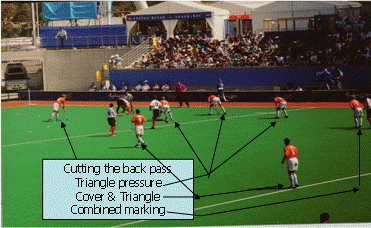
STRATEGY 1
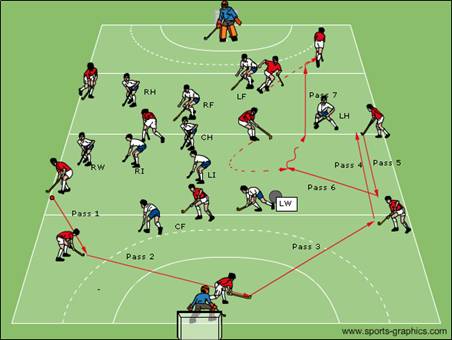
In the graphic above, the red team represents Canada, and the white team represents Netherlands in the game situation being analysed.
Strategy 1 results in ball movement that not only escapes the full-field press, but also generates a counter attack by exploiting the vacant space on the right side of the field.
In the actual game, there will be positional shifting by the defending team to create hurdles, and this is where players have to use their game sense to take the right game-time decisions.
STRATEGY 2
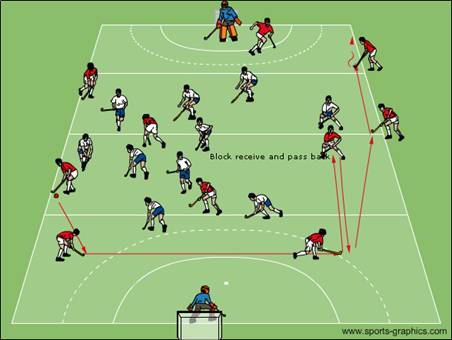
Strategy 2 is a variation of Strategy 1, where the Right-In has a give-and-go with the Right Full-Back.
STRATEGY 3
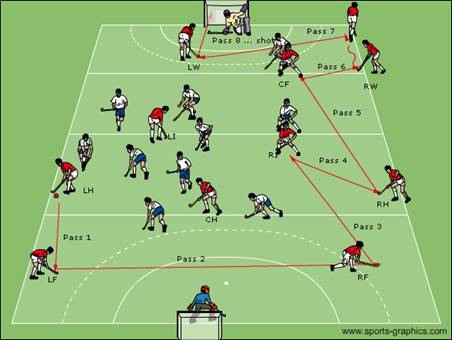
In Strategy 3, the ball traverses the length of the field, from the left flank to the right flank back to the left flank, before resulting in a shot at goal.
CONCLUSION
Multa novit vulpes, verum echinus unum magnum - The fox knows many things, but the hedgehog knows one big thing
- Erasmus
In this age of information overload, the problem is not of "Knowledge", but how to effectively apply the knowledge. Due to the available flow of abundant knowledge, athletes - both individually and as a team - have difficulty in making effective decisions during critical moments of the game. Players are drifting away from the simple basic concepts of the game, which give rich dividends most of the time.
In the fox and the hedgehog story, the cunning fox has many tricks/strategies in his bag, and the hedgehog knows only one simple, basic, but effective strategy. The end result is that the hedgehog wins, making the fox walk away time and time again.
I sign off with the KISS principle - Keep It Simple, Sportsperson.
![]()